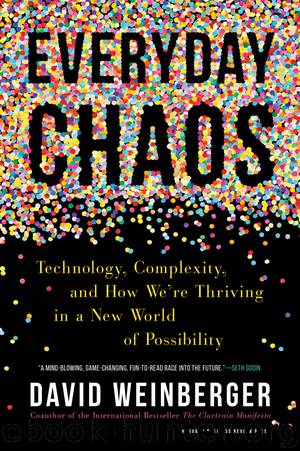Everyday Chaos by Weinberger David;

Author:Weinberger, David;
Language: eng
Format: epub
Publisher: Lightning Source Inc. (Tier 2)
* * *
If we turn inside out these five markers along the path that business strategy has followed, they become case studies in the perception of the nature of possibility. Let’s go back over them with that in mind.
1. During World War II, the possible actions worth considering were the ones that worked within the physical limitations of moving soldiers, supplies, and equipment, and that responded to the ever-changing, unpredictable situations on the ground. Possibilities were rooted in earth and mired in mud.
2. During the Cold War, possibilities arrived in the nose cones of unstoppable missiles that didn’t have to worry about fighting their way through enemy-held territory, about whether the rivers were swollen and the bridges intact, about how to get fresh water and canned rations to hungry soldiers. The missile launches in this model occurred in “turns”—retaliation for the enemy missiles that’d just been launched, followed by a counterretaliation—with nothing stopping the combatant nations except their willingness to press the button again. Never before had war seemed so much like playing chess.
Indeed, RAND’s approach removed the real world, with its mountains, rutted roads, and broken axles, from the “gameplay.” Thus, the possibilities were dictated by the logic of the game, not by the physical impediments. That logic consisted of the set of assumptions the combatants had about the rationality of their opponents, their willingness to sacrifice their populations, and the like.20 As you followed each possible branch of the tree of possibilities, you summed the costs and gains, the risks and rewards of this terrifying game of life, or more appropriately, game of Global Thermonuclear War.21
3. The scenario planning that began at Royal Dutch Shell treats possibilities as much more real. It does not assume that the movers are rational actors following relatively simple rules independent of what’s happening on the ground. It instead looks at the ground and sees complex, potentially disruptive forces at play that can only be ascertained by taking a wide view anchored in deep factual analysis. It asks how the world might surprise us with changes in every dimension, from the climate to disease to the rise and fall of despots. This is much closer to the World War II military’s on-the-ground understanding of possibilities than to the Cold War’s gamelike logical possibilities, except Shell’s scenario planning considers disruptions in the context itself and proceeds with less urgency, with more information, and from far more comfortable quarters.
4. McGrath’s transient competitive advantage approach to strategy sees possibilities as real, imminent dangers and opportunities that come and go based on the constantly changing interactions among all the pieces in all of the domains in which business operates: markets, customers, suppliers, employees, management structures, and so on. Being alert to these possibilities requires avoiding the assumption of the fixity of any element of one’s world. Where scenario planning looks out for planet-scale changes, McGrath urges us to be aware of the small changes that, because of the delicate interrelationship of every aspect of life, might push a business over the edge or give it a new handhold up.
Download
This site does not store any files on its server. We only index and link to content provided by other sites. Please contact the content providers to delete copyright contents if any and email us, we'll remove relevant links or contents immediately.
| Ethics | Etiquette |
| Fashion & Image | Health & Stress |
| Motivation & Self-Improvement | Work Life Balance |
| Workplace Culture |
Tools of Titans by Timothy Ferriss(6937)
Change Your Questions, Change Your Life by Marilee Adams(6637)
Deep Work by Cal Newport(5452)
Man-made Catastrophes and Risk Information Concealment by Dmitry Chernov & Didier Sornette(4729)
Big Magic: Creative Living Beyond Fear by Elizabeth Gilbert(4719)
The Slight Edge by Jeff Olson(4716)
The Motivation Myth by Jeff Haden(4521)
Digital Minimalism by Cal Newport;(4512)
Stone's Rules by Roger Stone(4413)
Ego Is the Enemy by Ryan Holiday(3982)
The Laws of Human Nature by Robert Greene(3936)
Tuesdays with Morrie by Mitch Albom(3830)
Rising Strong by Brene Brown(3777)
Eat That Frog! by Brian Tracy(3509)
Skin in the Game by Nassim Nicholas Taleb(3456)
The Money Culture by Michael Lewis(3277)
Skin in the Game: Hidden Asymmetries in Daily Life by Nassim Nicholas Taleb(3259)
Believe It to Achieve It by Brian Tracy & Christina Stein(3201)
Bullshit Jobs by David Graeber(3173)
